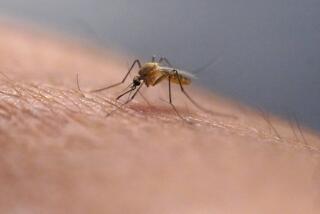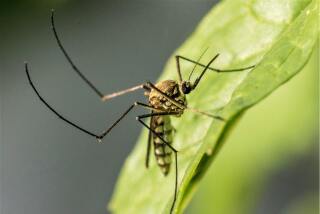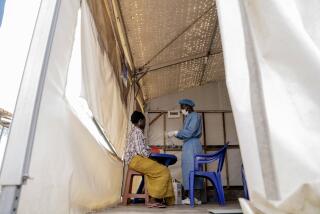New York Prepares for West Nile Virus Season
Public health officials in the New York area are hoping not to see a repeat of last summer, when the West Nile virus, a mosquito-borne virus never before seen in the Western Hemisphere, caused an outbreak of encephalitis in New York state. The brain infection was identified in 62 people and killed seven, although many more were probably infected, according to the federal Centers for Disease Control and Prevention.
Authorities responded with widespread aerial spraying of malathion, which residents protested. This year the city is applying larvicides to breeding sites.
When public health teams sampled mosquito populations in January and February in the New York City borough of Queens, the epicenter of the 1999 outbreak, they found the virus present in some “wintering” mosquitoes.
The West Nile virus, commonly and previously found in Africa, western Asia and the Middle East, is closely related to the St. Louis encephalitis virus, which is found in the United States. The West Nile virus is carried by birds, then transmitted to mosquitoes that feed on them.
It’s unclear how the virus got to the U.S., but the most likely explanation, according to health officials, is that it was introduced by an infected bird that was imported or a person coming to the U.S. from a country where the virus is common.
People 50 or older are at higher risk of getting the disease, says Dr. Stephen Ostroff, associate director for epidemiologic science at the Centers for Disease Control and Prevention’s National Center for Infectious Diseases. But the individual risk of contracting West Nile virus from a single bite is low. Most infections caused by the virus are mild and can include fever, headache, body aches and sometimes skin rash. More severe infections can be marked by headache, high fever, neck stiffness, disorientation and convulsions. The symptoms usually begin five to 15 days after the bite, according to the CDC. There is no vaccine; people who think they are infected and have symptoms should seek medical care.
To reduce the risk of being bitten, people can take common-sense precautions, such as wearing long sleeves and pants and applying insect repellent before going outdoors in the warmer months, especially during early morning and in the evening, the insects’ peak biting periods. The CDC recommends a repellent with a 20% to 35% concentration of DEET (N,N-diethyl-meta-toluamide). Mosquito season is April through October.
The migration of the West Nile virus to the U.S. is yet another example, Ostroff says, of emerging infectious diseases showing up in locations where they never before occurred and is tied to increased global travel and commerce. In 1991, cholera was reintroduced to Latin America after an absence of at least 100 years, probably in tainted bilge water released by a ship from Asia.
*
Healthy Traveler appears on the second and fourth Sundays of the month. Kathleen Doheny can be reached at kdoheny@compuserve.com.
More to Read
Sign up for Essential California
The most important California stories and recommendations in your inbox every morning.
You may occasionally receive promotional content from the Los Angeles Times.










